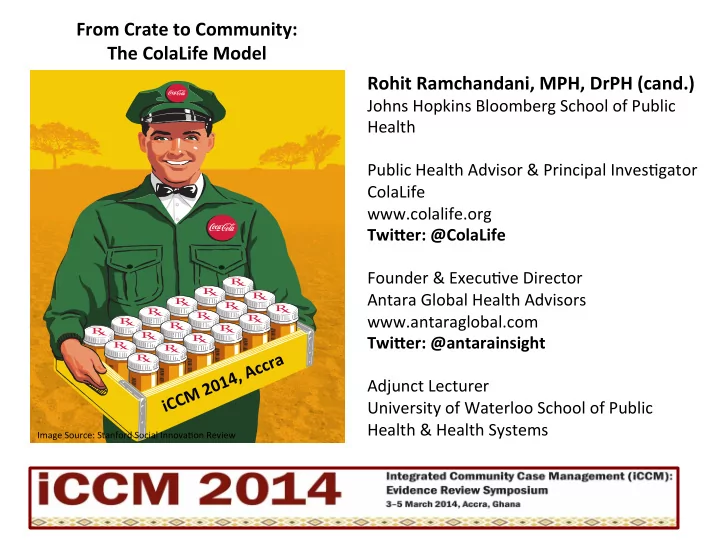

From ¡Crate ¡to ¡Community: ¡ ¡ The ¡ColaLife ¡Model ¡ Rohit ¡Ramchandani, ¡MPH, ¡DrPH ¡(cand.) ¡ Johns ¡Hopkins ¡Bloomberg ¡School ¡of ¡Public ¡ Health ¡ ¡ Public ¡Health ¡Advisor ¡& ¡Principal ¡Inves>gator ¡ ColaLife ¡ www.colalife.org ¡ Twi7er: ¡@ColaLife ¡ ¡ Founder ¡& ¡Execu>ve ¡Director ¡ Antara ¡Global ¡Health ¡Advisors ¡ www.antaraglobal.com ¡ Twi7er: ¡@antarainsight ¡ ¡ Adjunct ¡Lecturer ¡ University ¡of ¡Waterloo ¡School ¡of ¡Public ¡ ¡ Health ¡& ¡Health ¡Systems ¡ Image ¡Source: ¡Stanford ¡Social ¡Innova>on ¡Review ¡ ¡ STANFORD SOCIAL INNOVATION REVIEW �������������
iCCM Context in Zambia • Population: 13.5M • Population living in rural areas: 61% • 36% of deaths in children <5 due to malaria, pneumonia and diarrhea = 21,600 deaths (2010) • In 2010 diarrhoea was the 3rd leading cause of childhood mortality (9%) • Pop density: 13.5/km sq. (SSA avg = 25; Global avg = 45) • HRH crisis w/ only 7.8 nurses/midwives per 10K pop. • No seaport access • Frequent stock-outs of essential meds including ORS & Zinc
ColaLife’s iCCM Focus iCCM
Why the difference? Rural Health Centre Private, Community-level Shop
Kit Yamoyo Anti-Diarrhea Kit • Attractive • Affordable • Co-packages ORS and Zinc • Soap for hand-washing • Graphical Instructions/branding • 4.2g (200ml) sachets of flavored ORS • Packaging is also: • A measuring device for the water • A mixing device • A cup • A storage device (the soap tray is a lid) • Can be re-used • Originally designed to fit in empty spaces between crated bottles
ColaLife Value-Chain Customer K5.00 Community- Level Retail District-Level K3.70 Wholesale K3.10 Distribution Assembly Manufacture
Health Promotion
Simplified Results Framework Purpose Mothers in underserved rural communities increase use of ORS and Zinc in home treatment of diarrhoea Outcome Target communities in two under-served rural districts have improved access to ORS and Zinc Outputs ¡ Profit-driven supply chains improve availability of ADKs (anti-diarrhoea Access = ADK in the kits) in targeted communities in two hand of an aware mother/care-giver underserved rural districts Availability = ADK in Mothers/care-givers demonstrate stock in retail outlets awareness of ADKs and the benefits at community level of the contents (ORS, Zinc and Soap)
Study Design • Quasi-experimental pretest- Katete 1 posttest design with matched Kalomo comparators • Data collection in Aug-12 & Aug-13, midline in Mar-13 • 2 rural intervention districts (Kalomo & Katete); matched Monze Petauke comparators (Monze & Petauke) • Eastern Province (Katete & Petauke) & Southern Province (Kalomo & Monze), Zambia
Methods Over 2400 Household Surveys ~ 180 Retailer Surveys (>600 per district) (~45 per district) 30 Focus Group Discussions 20 Health Centre Impact Assessments
Some Key Findings from the Trial Some Key Findings From the Trial 1 In 12 months retailers serving remote rural communities bought over 25,000 Kit Yamoyo anti-diarrhoea kits. At baseline <1% of children with diarrhoea 2 were given ORS & Zinc. At endline, of those with diarrhoea in previous 2 weeks, 45% used both ORS and Zinc. 3 We reduced the distance caregivers travel to access ORS/Z from ~7 km (to a health centre), to ~2 km (to a local retail shop).
93% of Kit Yamoyo users prepared ORS in 4 the correct concentration, compared to ~ 60% using 1 litre sachets from RHCs. 62% shift in point of access of ORS/Z, 5 from formal health centres to private shops. Implications for decreased work load at RHCs. 6 We reduced the treatment delay – time from onset of diarrhea to treatment administration – from ~2 days to ~1 day.
7 Across our intervention districts, 95% of Kit Yamoyo retailers said they plan to continue selling the product going forward. 8 Only 8% of retailers put the kits in crates to transport them to the community-level. 9 Only 33% of care-givers gave Zinc for the full 10 days.
Key Considerations • With appropriate stakeholder development, a private sector ORS/Z product is acceptable at all levels. • Linking messaging around ORS/Z treatment with a specific product can improve uptake • Multi-sectoral partnerships and integrated innovation à scale
Key Considerations • The concept of developing value-chains for simple public health commodities (vs. supply-chains) can compliment existing systems • Demand-driven vs. supply led distribution: We can get products or services to anywhere in the world if we can create and sustain a demand for them and make it profitable to fulfill that demand • Leveraging existing local networks, as opposed to developing parallel systems, has numerous advantages
Key Considerations • To address issues of affordability in remote/rural, under-served markets, some level of subsidy (e.g. through vouchers) may be required until product costs are sufficiently low • The need for task shifting from primary health facilities to the community level has the potential of being partially fulfilled by private shops (at least for simple commodities) • Application of this model to other simple PH commodities?
Thanks to Our Donors
For More Information … rohit@colalife.org simon@colalife.org jane@colalife.org www.colalife.org Image credit: Claire Ward
Recommend
More recommend